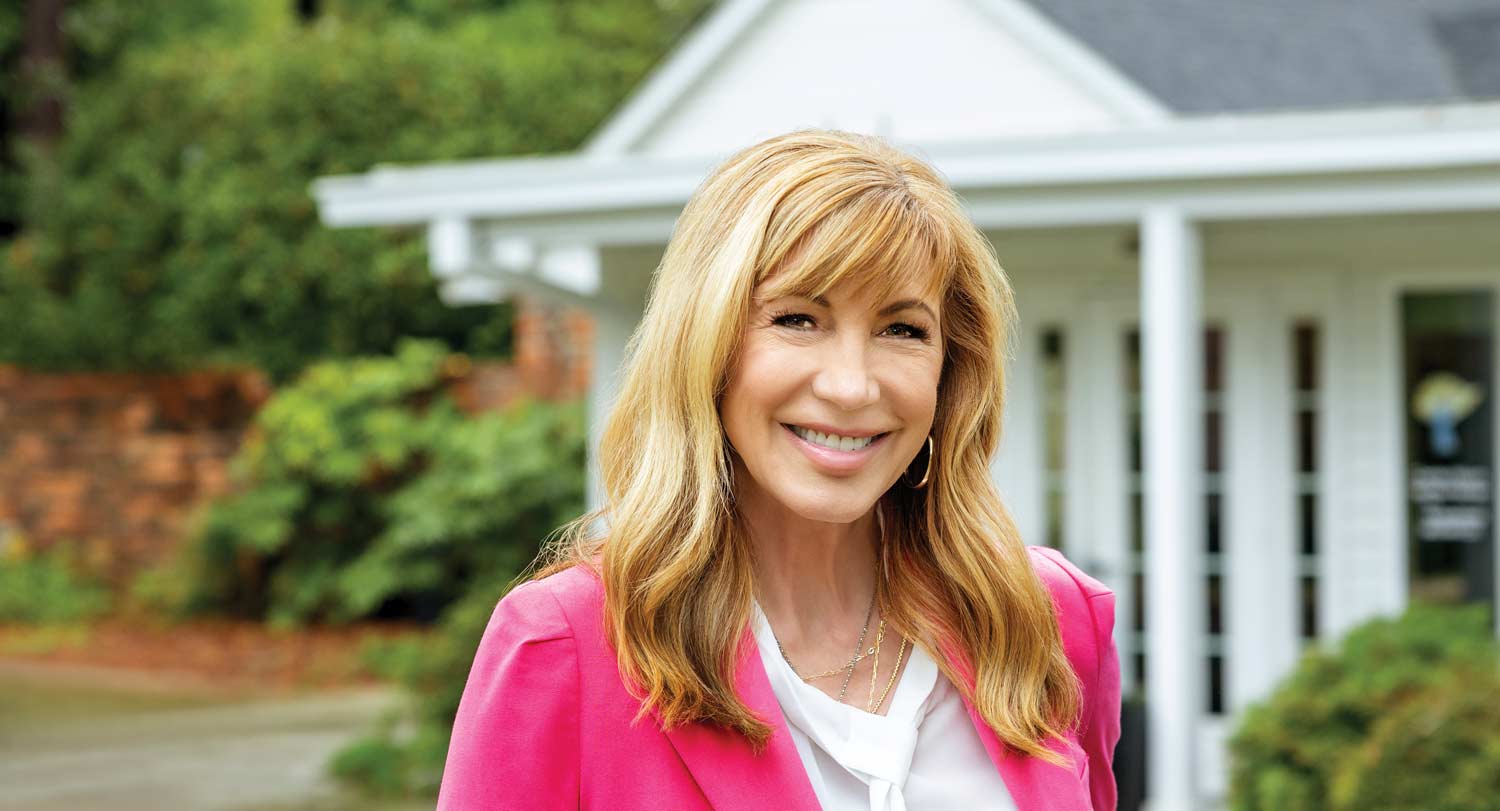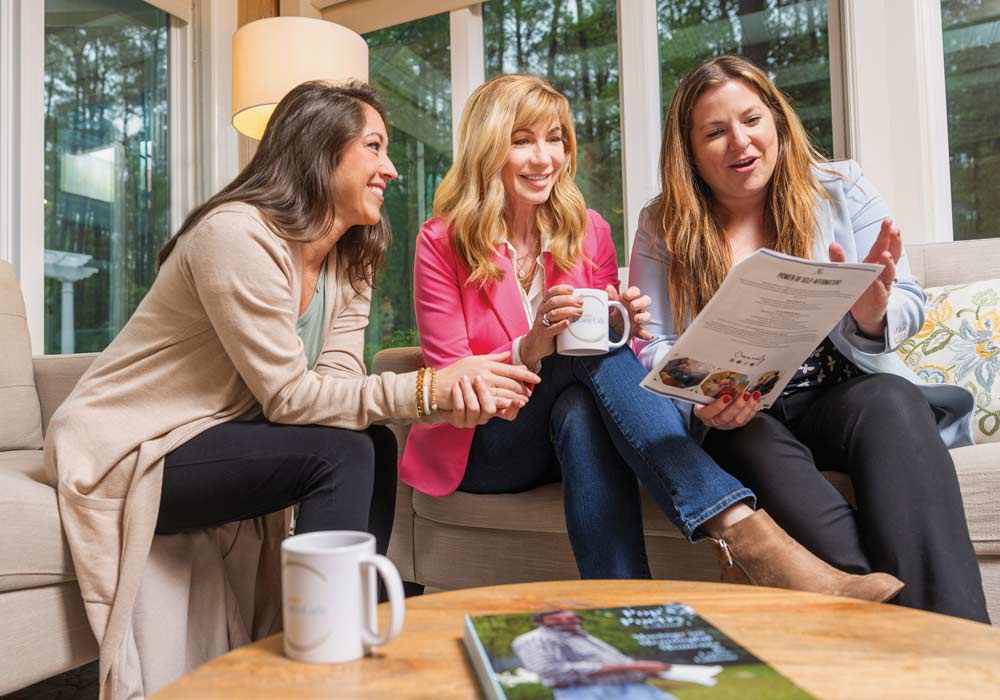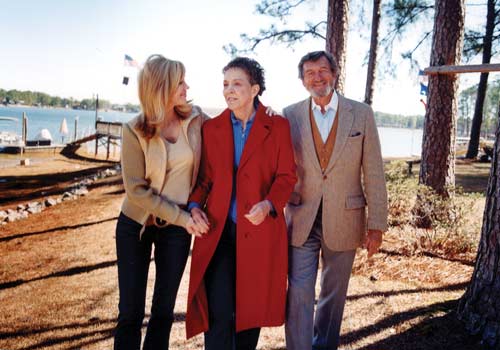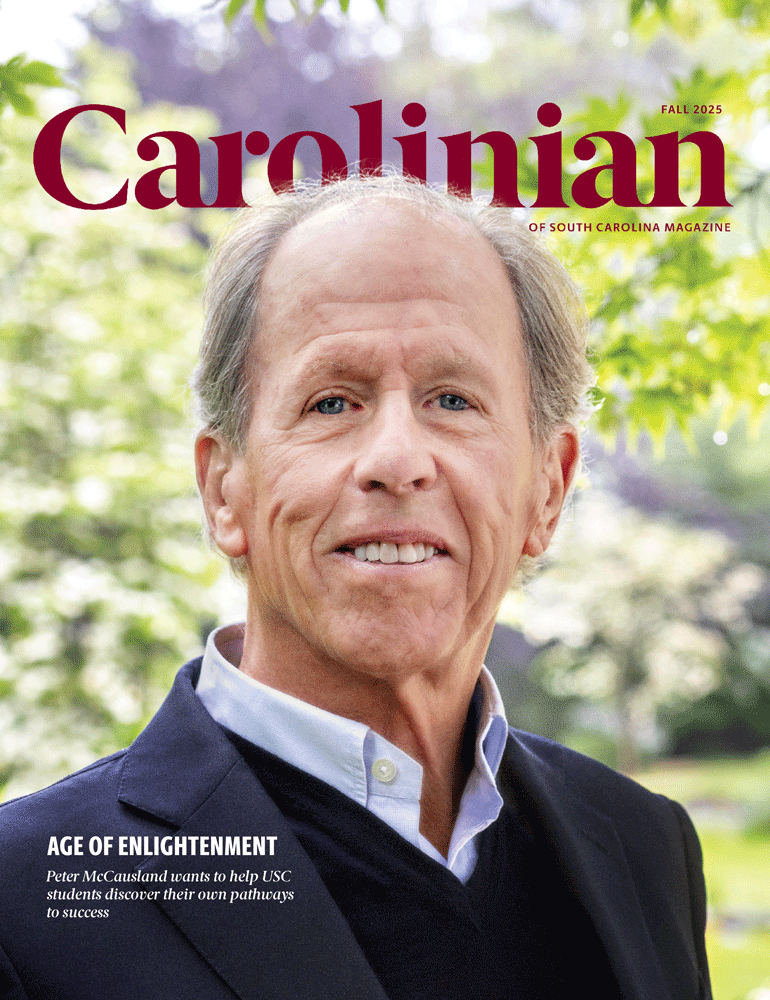
Locals know the house. The white brick two-story at the corner of St. Andrews and Tram Road, the L-shaped Cape Cod with the red door and black shutters. Midlands residents of a certain age will remember the wooden Whitehall sign in the front of the yard, the zigzag split-rail fence and lush flowers, the piney wood around back.
The family home of late residential real estate developer and longtime USC board member Michael Mungo became a landmark to the thousands of Seven Oaks residents who lived in Whitehall, one of Mungo’s first subdivisions.
Leeza Gibbons can tell you all about it. Before hitting it big as a television personality and Emmy Award-winning talk show host, Gibbons rode past the house on her bus route to and from school.
Today, the 1978 broadcast journalism alumna calls Los Angeles home. But the neighborhood where she grew up is still a big part of her story. After winning the Celebrity Apprentice reality TV competition in 2015, she used her prize money to convert the Michael J. and Mary Meech Mungo Home into Leeza’s Care Connection, a nonprofit center where caregivers can find resources, community and support.

Her motivation was personal. After Gibbons’ family was rocked by her mother’s Alzheimer’s diagnosis, she realized how families can be blindsided by illness. When caregivers give 100 percent of themselves to their loved ones, they often neglect their own needs.
And so she made sure that the center exuded warmth and comfort, that it felt like a home. There are cozy, gray sofas awash in window light, plush pillows, hot coffee. Most importantly, there are friendly faces and listening ears.
“The vision was to create a community gathering place that felt like a hub or oasis where you could exhale,” Gibbons says. “I’ve always believed we are on loan to each other in our lifetimes. Leeza’s Care Connection is a place where we count that relationship as sacred.”
The Optimists’ Daughter
Gibbons’ mission is driven by her own sacred relationship with her parents. Carlos and Jean grew up in rural Clarendon County, South Carolina, and married following Carlos’ return from the Korean War in 1953. While he pursued a career in education — he earned a bachelor’s and master’s from USC and a doctoral degree from the University of Maryland — Jean cared for the couple’s three children.
The family moved around plenty during Gibbons’ early years. There was a stint in Greenwood, then another in Hartsville, where Leeza was born. Eventually they moved to Columbia, where Carlos worked as executive director of the South Carolina Education Association. A natural leader, Carlos ran in the primary for state superintendent of education in the 70s. He didn’t win his party’s primary, but the experience helped prime Gibbons’ own leadership philosophy.
Most notably, Leeza Gibbons’ father taught her the power of positivity, a character trait that has guided her advocacy.

Leeza Gibbons with her parents, Jean and Carlos Gibbons
“My father is my favorite optimist, always focusing on what can be done, how things can change, what we can make better,” she says. “He is the one who encouraged me to call Michael Mungo’s son Stewart about finding a location for our center. He has been the emotional architect of my efforts and has bolstered me with encouragement, participation and financial contributions along the way.”
Jean, the social butterfly, influenced Gibbons’ conversational skills, laying the foundation for her broadcast career.
“My mother was comfortable with anyone, presidents and kings, and if she was at a big formal party, she would end up talking with the wait staff in the kitchen,” she says. “She just loved people at every level, at every turn.”
But Mom’s biggest strength was listening. Gibbons saw it firsthand while watching Jean serve as a caregiver during her own mother’s battle with Alzheimer’s.
“She focused on what was still left in her relationship with her mom, rather than the ravages of the memory-robbing disease that was taking her life,” Gibbons says. “She knew a heart never forgets, so even when Granny could no longer call her by name, the love was still shared between them. From my mother, I learned the power of shared silence. Being there, sharing space, is sometimes the greatest gift one can give.”
More of a Voice
In the dimly lit basement of the Carolina Coliseum, then home to USC’s College of Journalism, Gibbons honed her skills under some of the sharpest broadcast minds of the era.
Program chair Richard Uray had the hallmark gravitas of a seasoned broadcaster. “Everything Dr. Uray said seemed to carry much more significance because of that voice,” Gibbons says. “Just ‘good morning’ came across like breaking news.” Professor Lee Dudek then upped the ante: “On my first day of my first broadcasting class, he let me know, in no uncertain terms, that sitting in the front row, raising my hand and having a nice voice wasn’t going to be enough.”
Taken together, Gibbons’ faculty mentors helped her develop the poise for a career in front of the camera while also preparing her to take on an industry at that point still largely dominated by men. But change was coming.
In 1976, one year after Gibbons entered USC’s journalism program, ABC named Barbara Walters the first-ever female network news anchor, and she became the highest-paid newscaster in TV history. Her ascent heralded a shifting perception of women in journalism. Gibbons was inspired by Walters’ million-dollar salary and decided she would follow in her footsteps.
After graduating a year early with top marks, she took the path many broadcast alumni take and began working her way up through the various media markets — first Spartanburg, then Dallas, then New York City. But Gibbons had a knack for storytelling. And while celebrity journalism was never on her radar, when the newly launched CBS show Entertainment Tonight came calling in 1984, she knew Hollywood’s stars would have plenty of stories to share.
It was a fast climb from there. In 1993, she landed her own syndicated talk show, Leeza, which earned her three daytime Emmy Awards. She served as the main anchor and executive consulting editor of Extra and co-host and executive producer of America Now, both syndicated news programs. She also hosted the PBS talk show My Generation.
But work isn’t everything. In the midst of her career success, she and her family began to notice changes in her mother’s behavior. Jean stopped caring for her appearance. She repeated herself. She no longer seemed comfortable in social situations. In 1999, at just 63 years old, Jean was diagnosed with Alzheimer’s disease.
After a lengthy career advancing public education, Carlos transitioned into a new one — full-time caregiver. As Gibbons watched her father dedicate everything he had to the job, she realized her own career was incomplete.
“That was really when I found my seat at the table,” Gibbons says. “I knew my life was nudging me to make a change, and I couldn’t figure out where I should sit. And when I learned that people are dying just from the stress, just from compassion, from the assault on your system, I thought that’s something that we can really change.”
Making it Count
It’s estimated that a quarter of American adults serve as a caregiver in some capacity. The stress takes a toll. Older adults looking after a spouse are significantly more likely to die than non-caregivers of the same age.
Dementia requires a particularly high level of care. It’s not uncommon for caregivers to skip their own medical appointments; 40 percent of those caring for a spouse die before their partner, according to a Stanford Medicine study, and some estimates are higher. And because there is no caregiving manual, families quickly find themselves overwhelmed and unsure of where to turn for help.
“When Mom got sick, it was obvious to all of us that we were not ready for what was to come,” Gibbons says. “I realized everyone felt pretty much the same way — blindsided, attacked, defenseless.”
In response, she launched the Leeza Gibbons Memory Foundation in 2002; she opened her first caregiver hub, then called Leeza’s Place, in New York soon after. Eventually, Leeza’s Place became Leeza’s Care Connection, with locations based in her two home cities: outside Los Angeles in Burbank, California, and in Columbia.

Line dancing instructor Delia Hughes brightens the afternoon at Leeza’s Care Connection.
Her goal was to provide caregivers with support groups, activities and educational resources at a time when they needed help most. More than that, she wanted to fulfill a promise she’d made to Jean to “tell her story and make it count.” Advocacy was a way to do that and would give her an outlet for something else.
“My mother instinctively knew that my identity as a storyteller would offer me a refuge from the overwhelming sadness that comes from loving someone with Alzheimer’s disease,” Gibbons says. “She often encouraged me to simply ‘tell the story.’ I’ve found it’s good advice for anyone trying to make sense of the upheaval that it brings into your life. It helps to articulate the emotions, and in doing so, it often invites others to share.”
In 2015, she got the chance to tell that story far and wide when she edged out TV personality Geraldo Rivera to win the season finale of Celebrity Apprentice. Competing against others on the high-drama reality show was no easy feat for Gibbons — “I have a Ph.D. in conflict avoidance,” she jokes — but she knew what the prize money would mean for families back home.
“Winning the competition gave me a platform that truly changed everything,” she says. “It was important for me to find a place in my home state that offered what our family wished we’d had along the way — a place of help and healing where those who care can be seen and supported.”
Going the Distance
When Greg Green’s mother-in-law was diagnosed with early-onset Alzheimer’s disease in 2018, he and his family made the decision to move the retired charge nurse into their home.
“That’s what you do when you actually don’t know anything about Alzheimer’s, because you just think ‘I’ve got to take care of this person’ without preparing yourself to actually do that,” Green says. “We really didn’t have a clue of what to do.”
“Because it’s a house, it doesn’t feel like a center. It doesn’t feel like someone’s coming here to get care. It feels like a home.”
Within a few months, Green realized he needed help. He could no longer juggle caregiving and a full-time job. His family was stressed. Then he discovered the center and the activities it had to offer — the drumming circle, the art group, the weekly respite care, the men’s coffee club, the lunch-and-learns.
Initially, he was unsure if the center would meet his family’s unique needs. “I didn’t know if I was in the right place,” he says. “I didn’t know how much the care would be centered around our specific needs in dealing with Alzheimer’s and Blackness, for example. There were just so many different layers. I didn’t know what to expect. But it worked.”
He quickly found common ground with the other caregivers. Leeza’s became a refuge, a place where he could catch his breath.
“Because it’s a house, it doesn’t feel like a center,” he says. “It doesn’t feel like someone’s coming here to get care. It feels like a home. You can go in and sit in the living room. You can sit in the kitchen. Just doing that sometimes for 20 minutes is enough to bring that mental health piece and get you back on track.”
In the end, it’s really about the connections with other people who understand the situation.
“There’s nothing like someone saying, ‘I know what you’re going through. I understand. I’ve dealt with this and that,’” Green says. “There are some things in life we just can’t grasp through someone else’s lens. But with this particular life-changing thing, there are familiarities, there are parts and pieces that anyone who has cared for someone with Alzheimer’s is going to recognize.”
People with Alzheimer’s survive for an average of four to six years after diagnosis, but some live much longer. Caregiving, Gibbons likes to say, is a marathon, not a sprint, and human connection is one of the keys to going the distance. That’s why she and her team recently piloted HUGS, short for Helping U Grow Strong, a grant-funded program that pairs new caregivers with former ones for mentoring and support. HUGS has expanded into five states, and Gibbons has dreams of expanding the center’s signature Senior Prom event into other states, too.
“I will be fulfilling that promise I made to my mother for the rest of my life,” she says. “It keeps me in a relationship with her. Anyone who has lost a parent knows that we never lose the foundational love they give us — if we’re lucky — and the way they live forever is through the stories we tell and the way we pay that love forward.”
Heidi Treser’s 2022-23 field practicum at Leeza’s Care Connection helped her earn a bachelor’s in social work. And working with the center’s respite care program gave the Virginia native a deeper understanding of older populations, something she appreciates now that she’s home caring for her grandmother.
“I wish that something like this existed in every single city,” Treser says. “The need is so intense — it’s everywhere. But this organization is one of the only ones that really satisfies it.”
Heidi Treser (left) with staff at Leeza’s Care Connection
Treser is one of many USC students who has gained valuable experience at Leeza’s. In addition to providing field education to future social workers, the center offers volunteer opportunities for students in the Arnold School of Public Health. And in 2022, a team of students from the School of Journalism and Mass Communications — Gibbons’ alma mater — designed new signage and other free marketing materials as part of the school’s annual CreateAthon@USC event.
Students aren’t the only ones who learn something at the center. Caregivers learn more about how to meet their loved ones’ needs.
“Caregiving is such a significant responsibility, but the caregivers tend to belittle that responsibility for themselves. They don’t see how great it is,” she says. “Having a center like Leeza’s where you can come in and people can tell you how much of a hero you are — it changes people’s perspective on themselves. They realize how much of a difference they’re making.”
And everyone who crosses paths with Gibbons gets a lesson on the power of kindness. They also come away with a better understanding of Gibbons herself.
“I didn’t know that you could have so much of an impact and still be such a personable, down-to-earth kind of person like she is,” Treser says. “Everyone she speaks to, she devotes all of her attention to. It feels like she puts all of her energy into her hometown and the people who live here, and she cares so deeply.”
